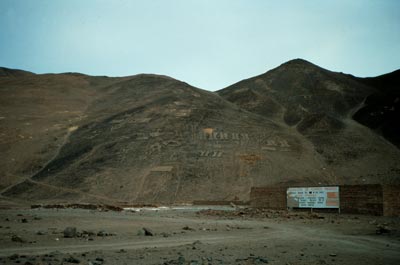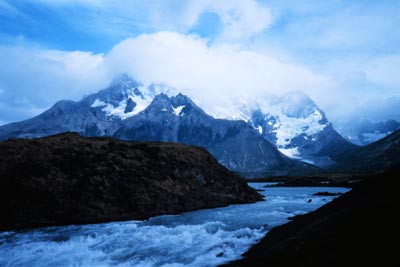Tidbits from Chile
by Deanna Palic
Hollywood goes to Chile
Chile’s landscape stretches from the northern deserts of Atacama to the southern glaciers of Patagonia, adorning it with a diverse and alluring array of scenery that is catching the eyes of Hollywood filmmakers and setting Chile apart as a hotspot for movie-making.
The Atacama Desert was recently selected as a backdrop for the next James Bond adventure, “Quantum of Solace,” which will be released this coming November.
Daniel Craig and the movie crew set up camp in Sierra Gorda, a town with a population of 1,000, in the Antofagasta region of northern Chile. Scenes were filmed against the rolling, rust-colored hills of the vast and majestic desert. Through his many adventures, James Bond has traveled to select intriguing locations around the world, and now Chile joins the exclusive list.
All, however, was not well on the set. Sierra Gorda’s mayor, Carlos Lopez, led a protest against the production. Mayor Lopez reportedly was miffed that Chile was being used in the film to represent its rival country, Bolivia — a sensitive issue in those parts.
Chile annexed a considerable chunk of mineral-rich northern territory from Bolivia and Peru in a victorious 19th-century war against its neighbors. Hard feelings still persist in all three nations.
New routes to Torres del Paine
Puerto Natales, the main gateway to Torres del Paine National Park, now boasts flights that connect the city with the rest of the country, including Santiago, Puerto Montt and Punta Arenas.
This development has been made possible thanks to the new service provided by SKY Airline, which lands at the “Teniente Julo Gallardo” airport on Tuesdays, Thursdays and Saturdays. Air Comet Chile service covers weekend flights.
Until now, visitors to Torres del Paine and other nearby attractions had to fly to Punta Arenas, which is three hours away by bus or car. These new flights allow flexibility for travelers to Chile’s Patagonia region.
Blue whales discovered
As Chile works to turn its waters into a whale sanctuary, it is quickly becoming the number-one whale-watching location in the world. It has been known as the home to humpback whales and has been monitored regularly for the rare blue whale, at one time nearly hunted to extinction.
Recently, three dedicated scientists made the exciting discovery of a previously unknown group of blue whales off the coast of the remote island of Melinka in southern Chile. This discovery is sure to bring even more whale lovers to the beautiful waters of Chile to catch a glimpse of these magnificent mammals.
For additional information, contact the Chilean Consulate (1734 Massachusetts Avenue NW., Washington, D.C. 20036; phone 202/530-4104 or visit www.chile-usa.org or www. sernatur.cl).
There’s a small hotel
For a more intimate retreat from Santiago’s hustle and bustle, Hotel Orly (Pedro de Valdivia 027, Santiago, Chile; phone 011-562-231-8947, fax 011-562-334-4403, e-mail info@orlyhotel.com or visit www.orlyhotel.com) is my personal favorite. I’ve stayed there twice.
Situated in the Providencia sector of Santiago, close to the Pedro de Valdivia subway station, the 1940s French-style mansion has 28 cozy rooms.
Room rates do not include breakfast but are reasonable: $95 single, $110 twin, $125 king or $140 junior suite. A special senior package, for adults over 65, offers a 10% discount and includes breakfast.
Cafetto Café, in the lobby, is usually packed with business travelers and well-dressed locals.
In the footsteps of Pablo Neruda
In 1994, upon the release of the Italian film “Il Postino” (“The Postman”), I became a fervent fan of the Chilean poet Pablo Neruda, a 1971 Nobel Laureate for Literature and one of the greatest Spanish-language poets of the 20th century.
Pablo Neruda was a prolific writer of passionate love poems, historical epics and political masterpieces. Forced into exile for his political views as a senator in the Chilean government, Neruda went abroad to be with his supporters and admirers throughout the world, including Pablo Picasso.
Based on true events, the film portrays the story of a shy postman who develops a growing friendship with the exiled Chilean poet Pablo Neruda. The film was a worldwide success. In 1995, “Il Postino” was nominated for five Academy Awards. It won for Best Original Dramatic Score.
If traveling to Isla Negra without an organized tour, from Hotel Orly simply take the metro from Pedro de Valdivia to Universidad de Santiago. When you exit the metro, you will end up in Santiago’s Terminal de Sur. Ask for the next bus to Isla Negra. There are frequent departures, and a friendly local will gladly show you the path to Neruda’s home.
The home is open 9:30 a.m.-8 p.m. Tuesday through Sunday, Jan. 2-Feb. 28, and 10-6 Tuesday through Sunday the rest of the year. A tour (in English) of the home costs approximately $8, and reservations are required. Visit www.fundacionneruda.org.
Although the people of the world were Neruda’s travel companions and he lived in various countries on several continents throughout his life, Chile was his birthplace, and his home in Isla Negra was his true residence.
Originally a cottage of 70 square meters that he bought in 1939, the house was consistently remodeled to accommodate Neruda’s magical vision of life. One of the very first modifications he made to the house was the addition of a grand window in his bedroom, overlooking the crashing whitecaps. He was fascinated by Chile’s seas.


